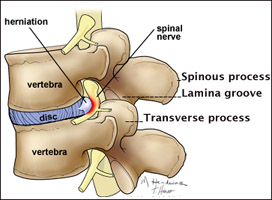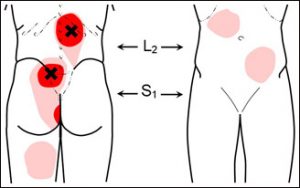This is a series on low back pain. If you missed the summary of causes, go back to Part 1.
In my Neuromuscular Therapy center near Boston I am finding more and more that the lumbar portion of little multifidi (and sometimes the rotatores) muscles is a big cause of low back pain. They form a rather thick pad of tissue at and across the lumbosacral juction. That’s the portion of the spine between the lowest lumbar vertebrae and the sacral base of the spine between the hip bones. The multifidi lie deep in what is called the lamina groove of the spine between the transverse processes of the vertebrae that attach to the ribs and the spinous processes that you see as the bumps of your spine.
That’s the portion of the spine between the lowest lumbar vertebrae and the sacral base of the spine between the hip bones. The multifidi lie deep in what is called the lamina groove of the spine between the transverse processes of the vertebrae that attach to the ribs and the spinous processes that you see as the bumps of your spine.
How do the multifidi cause pain? The action of the multifidi is to rotate and extend the spine (the rotatores mostly rotate and cross only one or two vertebral segments whereas the diagonal bands of multifidi span 2-4 vertebrae.) The lowest bands of the multifidi cross the L5/S1 space and attach to the sacrum as far as S4. The function of this muscle group is primarily stabilization of the spine.
Travell and Simons list the major causes of low back pain as 1) sudden overload when lifting something heavy, especially from a twisted position and 2) sustained overload from postures where the back is bent forward or when you have a “sway back”(hyperlordosis). 3) I find that prolonged shortening of the muscles in certain positions can tighten the muscles and cause pain and spasm. This happens when you have tight hip flexor muscles. When the hips are flexed you can’t stand up straight without arching your back.
When you lift a heavy object, the muscles have to tense up to hold the weight (stabilization). Likewise, when you are bent over all the time the muscles have to work to hold you there. If you are hyperlordotic, the muscles are shortening and accentuating the curve of the lumbar spine. Prolonged shortening depletes the muscle’s blood supply. The muscles can’t work without sufficient blood. All of these actions and functions use the multifidi muscles and cause pain in the low back.
 Trigger Points from the multifidi mostly spread out into the surrounding area causing local back pain, but they can refer down into the buttock, into the tailbone (coccyx) and into the back of the thigh and leg. They can also surprisingly refer into the front of the body to the abdomen with pain that can feel like it’s coming from the internal organs. Trigger Points from the rotatores center on the spine. Both muscle groups can cause pain that feels like it’s coming from the bones.
Trigger Points from the multifidi mostly spread out into the surrounding area causing local back pain, but they can refer down into the buttock, into the tailbone (coccyx) and into the back of the thigh and leg. They can also surprisingly refer into the front of the body to the abdomen with pain that can feel like it’s coming from the internal organs. Trigger Points from the rotatores center on the spine. Both muscle groups can cause pain that feels like it’s coming from the bones.
Nerve entrapment can occur as some of the spinal nerves make their way through these muscle groups out to the skin of the back. Tense muscles press on the nerves. Taut bands from Trigger Points can effectively reduce the flow of nerve signals and produce abnormal sensations on the skin including hypersensitivity and loss of sensation.
Joint compression happens when the muscles get tight and squeeze the bones together that they cross. When muscles get overloaded and strained beyond their limit, the ligaments have to stiffen up to protect the joint. The joints have nerves in them that will fire off when they are stimulated by the compression. In the low back you have vertebral joints, facet joints, the lumbosacral joint, and the sacroiliac joint. All except the facets are held together by ligaments and all are moved by muscles and tendons. (Look in a later post about the ligaments.)
Working with these deep paraspinal muscles are the superficial paraspinals. That information is in the next post.